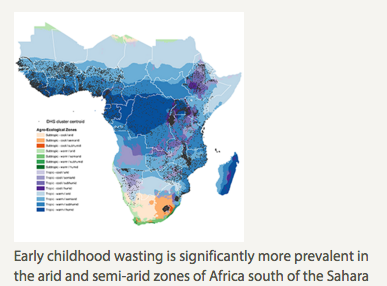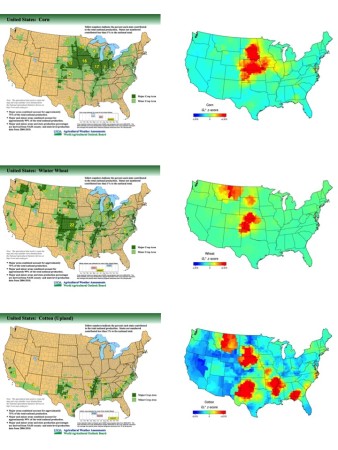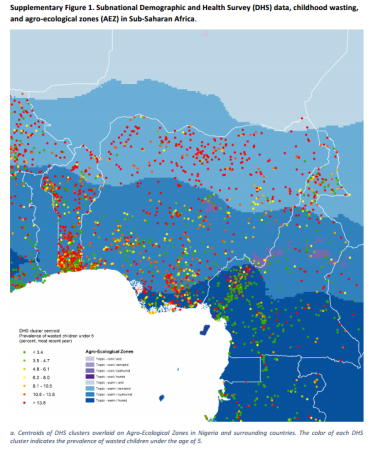- Species flying poleward.
- FAO unveils pulse infographic. No word on whether any are harvestable by machine.
- Potato farmer adds value the old-fashioned way.
- Talking of old, here’s a really old horse.
- And the oldest evidence of fermentation for food preservation. But you’ll need a strong stomach.
- KitKat is certified crap.
- How (and Why) Farmers Maintain Crop Diversity: The Book. Some reviews.
- And here’s a specific example from India.
- And here, courtesy of Bioversity’s Ann Tutwiler, is why farmers need some help sometimes.
- Oh and here’s another one. People visit ICRISAT genebank in Niger, see stuff they like.
Varietal diversity in pulse nutritional quality to be documented, maybe even used
Good to see FAO taking the lead in pulling together nutritional data on pulses, in celebration of the International Year of Pulses. Especially since variety-level information will be sought, according to FAO Nutrition Officer Ruth Charrondière .
…if a micronutrient deficiency is identified within a certain region or population, governments and nutritionists can pinpoint the varieties of pulses that contain the highest levels of the micronutrients, and encourage their production on farms and home gardens in these areas. Governments can also use the data to enrich food based dietary guidelines and national food composition tables. Furthermore, researchers and the private sector can use the food composition data to develop new, nutrient-rich varieties of pulses through cross-breeding and selective breeding, and include these improved varieties in mass production programmes.
There is demand for that sort of thing.
Tweeting crops
Jack Grieve is a computational linguist at Aston University in Birmingham, England. I came across him on Twitter, where he occasionally posts fun maps showing the geographic distributions (usually within the USA) of different words, usually dialectical variants, based on their appearance in geocoded tweets. He very kindly ran a couple of crop names through his magic box for us, and this is what he got. I wanted to know if the distribution of crops could be inferred from where people tweet about it more than the average. I’ve placed his map for each crop side by side with the relevant distribution map from USDA.
Not a perfect match by any means, but not too bad. Except for cotton, that is. Any ideas why people should be tweeting so much about cotton in the northern Great Plains? They’re certainly not growing it.
Jack’s dataset apparently only covers the US and the UK at the moment, which means I can’t check whether Kenyans, say, are tweeting about maize particularly assiduously where they’re growing it, or indeed about maize lethal necrosis where they’re worried about it. Google famously tried to predict flu outbreaks from search patterns, but that seems to have fizzled out. Could tweeting trends help pinpoint crops (or livestock?) and their pests and diseases in space and time? I don’t see much of that kind of thing in the discussion of ICTs in agriculture.
Nibbles: Solutions edition
- No new salinity tolerance in cereals? You need to look at the right thing.
- No new crops? Focus on plants’ sex lives.
- No hope for drylands? Look to biodiversity.
- No new agricultural land? No problem.
- No data on neglected Himalayan crops? Got you covered.
- No way you’re drinking coffee from civet droppings? Chemistry to the rescue.
- No place for the offspring of F1 hybrids in your agriculture? Go apomictic.
- No new fruits left to try? Hang in there.
- No diversity in your Aragonese homegarden? There’s a genebank for that.
- No impact for your agricultural research. Try clusters.
- No agroecological patterning to your crop’s genetic diversity? It’s the culture, stupid.
Well, since we’re calling for paradigm shifts…
There’s a lot that’s both nice and deliciously ironic about IFPRI’s recent blog post “Granular socioeconomic data are increasingly becoming available in agricultural research.” This summarizes a letter to Nature Climate Change from HarvestChoice scientists which adds some nuance to a previous commentary in that journal calling on socioeconomists to up their data game. The point is a good one, and it’s stated right up front in the post, quoting the letter:
Spatially explicit, harmonized socio-economic data products are increasingly available to the public, such as population and poverty grids, microdata derived from national household surveys, and rasterized sociodemographic indicators. While these products are often overlooked in the economic literature, they are well suited to the study of climate’s impact on human geography across scales.
But, then comes the irony.
 First, both the letter and the original article, helpfully linked to in the blog post, are of course behind paywalls. Second, the map included in the post is provided with an incorrect caption. There’s a screen grab here on the left. As you can see, the caption suggests that the map illustrates that childhood wasting is more prevalent in the drier areas of sub-Saharan Africa. But the map shows no such thing, as a glance at the legend, or indeed the map in the original letter, will prove. What the map caption should actually be is “Subnational Demographic and Health Surveys (DHS) data showing centroids of DHS clusters overlaid on Agro-ecological Zones.” Not quite so catchy. The map showing the relationship between wasting and agroecological zones is this one, and it’s in the Supplementary Materials to the letter. ((Which, bizarrely, seem to be freely available.)) I hope I don’t get into trouble for reproducing it here, but it is pretty cool.
First, both the letter and the original article, helpfully linked to in the blog post, are of course behind paywalls. Second, the map included in the post is provided with an incorrect caption. There’s a screen grab here on the left. As you can see, the caption suggests that the map illustrates that childhood wasting is more prevalent in the drier areas of sub-Saharan Africa. But the map shows no such thing, as a glance at the legend, or indeed the map in the original letter, will prove. What the map caption should actually be is “Subnational Demographic and Health Surveys (DHS) data showing centroids of DHS clusters overlaid on Agro-ecological Zones.” Not quite so catchy. The map showing the relationship between wasting and agroecological zones is this one, and it’s in the Supplementary Materials to the letter. ((Which, bizarrely, seem to be freely available.)) I hope I don’t get into trouble for reproducing it here, but it is pretty cool.
And thirdly, and most importantly, frankly neither the socioeconomic datasets nor the agroecological map which the HarvestChoice researchers cleverly mashed up to make their point about data availability are exactly easy for the average non-GIS geek to use, let alone to combine. Try it and see.
The original paper calls for a “new paradigm in data gathering.” The blog post echoes the follow-up letter in saying “the paradigm shift is alive and kicking already.” Oh good. But I’d like to be able to look at the distribution of stunting and other nutritional indicators together with the distribution of different crops and varieties without having to beg a GIS person to do it for me, or spending half a day putzing around trying to understand what this means
Data layers are available in comma-separated values format (.csv) suitable for MSExcel, in ESRI ASCII Raster (.asc) and GeoTIFF formats (.tif) suitable for any desktop GIS tool. To view ASCII or GeoTIFF rasters in ArcMap or QuantumGIS simply drag and drop the downloaded files onto the layer pane.
Sure, have your paradigm shift in data gathering. But can I also have one in usability, please?

